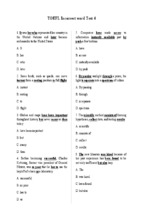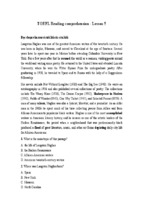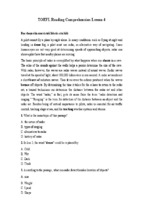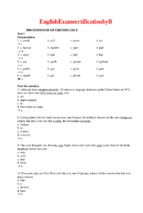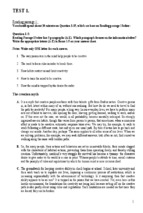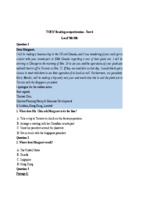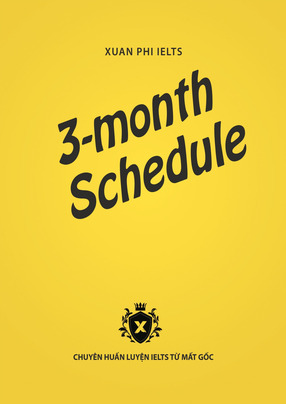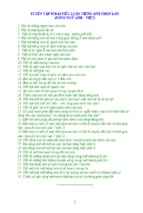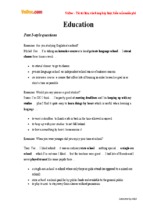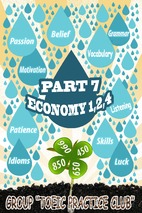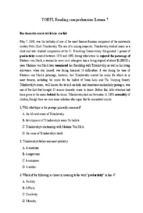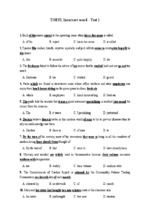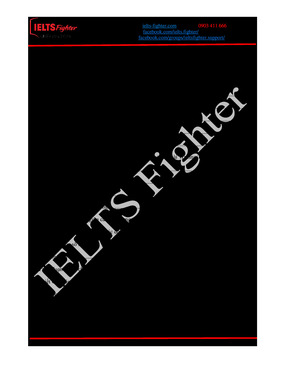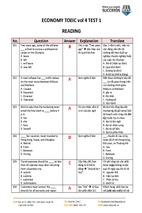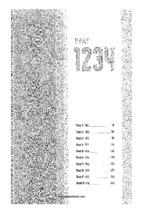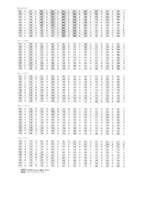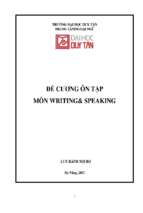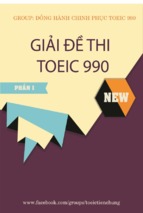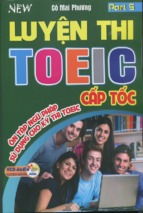!
tr\
*' a
II
Contents
To the Teacher iv
To lhe Student v
lntroduction
2
. Formatting assignmentsand writing headings
a Processwriting
I Beginning to Work
a
.
a
.
.
5
Recognisingand writing complete sentences
Beginningand endin8a senlence
Commonparagraph features
Identifying the topic ofa paragraph
Identifying strong and weak paragraphs
2 Giving ond Receiving Presents
t3
. Identi&int topics and main ideas
. Identifying strong and weak topic sentences
. Writing lopic sentences
. Combiningsentences
using ond and buf
. Using commasin sentenceswith ond and but
3 A Fovourite Ploce
.
.
.
o
.
Developing paragraphs with descripiive detail8
Using lists to brainstorm
Learning to edit lists
Combinint sentenc$ containing adiectives
Writing aboutplaces
4 An Exceptionol Person
a
.
o
.
.
34
Review of descriptive vocabulary
Usin8 freelriting to brainstorm
Reviewofparagraph contents
Developintpeer feedbackskills
Writing about a trend
5 tl{hite Lies
a Opinions and examples in supporting sentences
. Usin8 discussion to brainstorm
. Writing about your opidions
ii
25
Using word maps to brainstorm
Using adiectives in sentences
Writing concluding sentences
Using capital letters
Wdting about people
5 Trendsond Foshions
.
.
a
.
.
20
CoNTENTS
42
7 Explon otions ond Excuses
48
Paragraphsexplaining causeand effect / result
a Combiningsentences
with so and because
a Practising word maps and freewriting
a Writing about explanaiions and excuses
I Problems
55
a Expressingpersonal feelings about problems
Using would like to, wg,nt to, ali.dhave to
Logicalorder of supporlingsentences
Editing lists by ordering ideas logically
a Writing about problems or difficulties
9 Stunge Stories
62
a Using time expressions:afte4 before, and wien
Identifoingl-bemain pafis of a narralive
Ordering events in a nanative logically
Wriling aboutinterestingor unusualexperiences
l0 Differences
.
a
.
.
.
69
Using double lists to brainstorm
Using w}ereos and ftowerzerto make comparisons
Organising a comparison paragraph
Comparing different situations / events
Writing about life changes
I I Dfficult Decisions
f5
Writing about causeand efrect relationships
Using pair interviews to brainstorm
Beginning paragraphs with a question
a Writing about a difficult decision
t2 Fote or Choice?
a
a
a
a
80
Writing about hopes and plans for the future
Review of brainstorming techniques
Review of hansition expressions
Writing about the future
Additionol Moteriols
85
Grammar for Writers
Puncfuation
Irregular Verb List
a Samplebrainstorming, first draft, peer review forms, and final draft paragraph
Answer IGy
Photocopioble Materiols
94
t03
CONTENTS iii
To theTeocher
Writing is an important form of communication in day-to-day life, but it is especially
important in secondaryschool and university. WritiDg is also one of the most difficult
skills to master in both a first languageand a second language.Students can find it
challenging to find ideas to include in their writing, and each culture has its or,.n style
lbr organising academic writing. However, with the help of this book and your
guidance, your students will learn to recognisegood academic paragraphsand develop
their own paragraphwriting skills.
Writing in Pamgaphs is designedto help low-intermediate students aralyse model
paragraphs,find ideas for their writing, put their ideas into sentences,organisetheir
sentencesinto paragraphs,review their paragraphs,and revise their paragraphsso that
they become even stronger.This processapproach to wdting will not only develop your
students' paragraphwdting skills, but will also encouragethem to become independent
and creative lrriters.
Pre-writing
\/vriting
Reviewint and Revising
Each main unit provides an interesting theme to engageyour students and motivate
them to read and analyse the model paragraphs.The unit themes also inspire your
students to createtheir own writing. An introductory unit looks at how sLudentscan
format ttreir writing and introduces the idea of processwriting.
The activities in each unit help students with a particular aspectof paragraphwdting,
such as brainstorming, wdting topic sentences,and developing paragraphswith
supporting sentences.A unit's activities might also teach correct punctuation for
academic writing arrd useful grammatical functions for wdting, such as conjunctions
and transition expressions.The units also show students how to review ttreir own and
their classmates'writing in order to make rcvisions.
Each unit ends with a sbuctured wdting assignmentthat provides an opportunity for
students to use everything presentedin the unit. Included in this book are samplesof a
paragraphlrom brainstorming to final draft, with a completed peer Review Form. There
is also a guide to common grammatical terms and concepts useful for writers, a list of
irregular verbs and their past tense forms and participles, and a guide to punctuation.
Finally, tlere is an answerkey with answe$ to most oftlle exercisesand a photocopiable
section with blank Peer Review Forms and a Writing Survey you may like to do with
your studenlsal the startof lhe course.
Learning to write well takes a lot of practice and patience. Students need clear
guidance, positive feedback,and interesting ideas to wdte about. We hope this book
provides tiis for you and you enroy using it.
iv
To THETEACHER
Io the Student
Writing is a very important part of your schoql and university study. You will write
assignmentsthat may be one paragraphor several paragraphs,and you will write answers
for tests and examsthat may be a few sentences,a paragraphor two, or a complete essay.
Academic wdting in English may be different not only ftom academic wdting in your
own language,but even ftom other writing in English. The purpose of this book is to help
you recogniseand prcduce the sort of paragraphwriting that will be expected of you in
academic situations.
During tli6 course, you will have many opportunities to study and discuss examples of
English academic paragraphwriting. You will also have many opportunities to discuss
your own paragraphsard the paragraphsof your classmates.You will learn how
important the rcader is to tie write!, and how to expressclearly and directly what you
mean to communicate. We hope that what you leam in this course will help you
throughout your academic studies and beyond.
You should come to your writing class every day wittr energy and a willingness to work
and learn. Your teacher and your classmateshave much to sharewith you, and you have
much to sharewith them. By coming to class with your questions,taling chancesarrd
bying new ways, and expressingyour ideas in another language,you will add not only to
your own world, but to the world of those around you, Good luckl
TO THESTUDENT V
Introduction
In
r
I
I
this unit, you will learn ...
formatting for assiSnments.
how to write headings.
about processwritinS.
LoyoutlFormatting
I a Match the words about layout with their deffnitions.
a. paragraph
b. margin
c. double line spacing
d. indent [v]
e. title
t. font
1. To start a paEgraph further in from the edge of the page than the rest of the text'
2. The spaceat tle side of the pagewhere notling i5 wdtten
3. A set;f lettels in one size and style used for printing and computer documents'
4. A section of a piece of wdting that starts on a new line and contains several sentences'
5. The name of a piece of writing
6. A style of spacing where there are two blank lines between each line of text
There are no set rules about how you set out your paragraphsand they can be hand
britten or word-processed lt is down to personal preferencewhether you use indentation'
double line spacing or a certarn font, unless your school or uaiversity has specific
requirementsl Howwer, the general rule is that paragraphs should be clearly visible, easily
readable a.rtdilr one font, which is usually black
I b Look at these student papere. Tick (/) the one that is befter for an acailemic assignment'
Schooluniformsare notgoodior students.
so studentsfeelbadwhen
Theyare not attractrve,
them.Studentsliketo express
theyarewearing
theirownclothes
bychoosing
theirpersonalities
INTRODUCTION
schoot uhtfoths ate ^ol soal {ot studehts
rAeA arc tot \traclire, so studehtsfeel bad
uteh the| ale hlearihgtheh Studehk like to
exp/ess lheit pelsohalilies bg choosing theit
2
Look at thesedifierent waF ofwriting headingsfor student papers. Answer the
questions below.
a.
?rofei6orMillgr
English
WrinngI
1.
2.
3.
4.
What is the writer's n€me?
What is ttre name of ttre class?
Who is teachingt}Ie class?
What is the title of ttre assignment?
b.
Sebastian
Mitchell
Schooluniforms
2nd draft
5 September,2004
StudentsShouldChooseTheirOwn Clothes
1.
2.
3.
4.
5.
What is ttre writer's name?
What is ttre title of tle assignment?
What is the assignmentabout?
\ Ihat does'2"ddmft' mean?
\Alhendid ttre miter write the assignment?
How does your teacherwant you to u,Titeheadingsin this class?
Write arr exanple here:
INTRODUCTION 3
Processwriting
Take a quiz! First guess the correct answers. Then read the paragraphs below to check
your 8uesses.
a. 'Processwriting' means
E
writing in English.
E
writing with a word processor.
E
writing in severalstages(stepsr.
d. Your teachermay askyou to wdte
anotherdraft.This is because
n
your teachercan't think of any
new assrgnments,
I
the first time, your paperwas
bad.
finish the homeworkfor your
otherclasses.
n
yon
-"k" your paperbetter
"ur, somechanges.
by making
n
get someideas.
n
askyour ftiendsfor help.
Before you hand in your paper for a
grade,you should
b. Beforeyou beginto write, you should
c. Your teachermay askyou to reada
classmaif''s
paperandarswersome
questionsaboutit. This is because
n
you can l""rr, .lot by reading
your classmate's
assignment.
n
ask your teacherto give you a
good grade.
n
checkit caretully.
!
put someprettystickerson it.
your teacheris too busy to read
all the students'papers.
E
you are a better writer than your
classmate.
Musicians pmctise their pieces many times before a concert. Athletes work out before
a competition. In the sameway, good writers go through several stageswhen they
u,'rite.'Plocesswdting' will guide you through these stagesso your final paper is really
your best effort.
b . The first stageof processwdting is getting ideas. In this course, you will learn and
practise several different ways to get ideas. Try them all and see which way works
best for you.
c . An important stagein process\,'riting is sharing yoru \,'dting. You can see how other
writers like you haidled the same assignment,and you can get some good ideas ftom
them. You can also seehow well someoneelse understandsyour ideas.
d . After you finish your assignment,put it away for some time. When you look at it again,
you may have new ideas. Your classmatesmay help you find new ideas, too. Writing
your paper again (called 'revising') gives you the chance to improve your paper.
e. Before you give your teacheryour paper, check it carefully. Read it aloud. Does it
sound natuml? Did you forget any words? Did you rememberto write the heading
correctly?Does your paper look neat?Rememberto give your teacheryour best effort!
INTFODUCTION
BeginningtoWork
In
I
I
I
r
r
this Dnit, you will ...
reco8nise and write complete sentences.
learn how to begin and end a sentence.
learn the common features ofa paragraph.
identit/ the topic ofa paragraph.
idendry shong and weak paragraphs.
Look at this chart. Tick (/) the answers for vour countrv.
It's common.
lt's not common.
I'm not sure. /
It depend-s.
a. Secondary
schoolstudents
havepart-timejobs.
b. Universitystudents
have
part{imejobs.
c. Universitystudents
have
jobs (iobsthat
volunteer
don'tpay a salary).
d. Part-timejobs paya
goodsalary.
e. After graduation,
bothmen
andwomel wantto find a
full-timejob.
Share your inforrnation wilh a group ofyour
classrnates.Ask and answer these questions
about part.time jobs,
o What are common part-time jobs?
a Have you ever had a job? What was your
first tob?
What kind of job do you think is best for
a secondaryschool / university student?
(your idea)
BEGINNING
TO WORK
1
You are going to read a paragraph called Port-time lobs and Secondory School,What
do you ttrink the paragraph is about?Circle the answer,
a. lJsefulsecondaryschoolsubjects
b. Workingand studyingat the sametime
c. How much moneya parFtimejob pays
4
Read the paragraph. Did you choosethe right answer in exercise 3 above?
Part-timeJobsand SecondarySchool
1 Secondsryschool studentsshould
not havepart-timejobs.2 Secondary
schoolis a very importanttime for a
sfudent,and studentsarevery busy,
3 Studentshaveto Etudyhard to
entera gooduniversity.a Many
secondaryschoolstudentsalsoplay
sports,and ttreypractisebeforeand
afterschool.s Secondaryschool
studentsalsospendtime with
Iriends of the sameage.6 Those
ftiendshipscanbe importantfor ttre
rcst of ttreir lives. 7 A part-timejob
takes time away flom studying,
playing sports,and makingftiends,
I Peoplework for most of their
adult lives. e Whenthey are in
school,it's importantfor them to
just be students.
5
Which sentencetells tle rwiterk most imDorta.ntidea?
r!
6
2E 3n
Bn
what do sentences
3,4 and 5 do?
a. They show new idea6.
b. They give examples.
c. They show differentopinions.
7
Do you agreewith tle writer? Why / Why not?
BEGINNING
TO WONK
1
Writing focus:What is o sentence?
How many words are in the shortestEnglish sentence?Except for one-word commands
(Sitl), a complete sentencein English needs two wordsi a subject (a noun or pronoun) ald
a predicate (a verb) (Sfie sits).
Of couNe, most English sentencesare longer than iust two words, but every sentencetells
a complete thought. Groups of words that do not mate complete sentencesare called
phtases.
If you need morc infomation on complete sentencesand phrdses, seepdges 8eF88.
I
Work with a partner. Look at the following. Some of them could be sentences with tle
correct punctuadon, fick (/) the ones that could be sentences.
a. L--.1 after school
b. L--.1 we Iove \,lriting in English
".
n
hi. fti"rrd. -e not in his class
d.
the man in the stripedsuit
e. E
at threeo'clockin the afternoon
f. !
graduatedin May
g. n
is goingshoppingthis weekend
Longuogefocus:Copitol letters ond finol punctuation
Sentences
in a paragraph...
. sta with a capitalletter
Part-time jobs can be I ssful.
o end with a full stop (.) questionmark (?l or exclamationmark (l)
Mony students work as tutots,
How old wereyou when you got yout fitst job?
I will nevet work in o rcstouront again!
Note: Exclamation marks are not as common in academicwdting as they are in
casual writing. Don't use them too often. Never use more t}lajr oDeexclamation
mark at the end of a sentencein academicwriting.
The company offered me o part-time job!! = when writing to ftiends
The company offered me a part-time job. = when l rriting in school
BEGINNING
TO WORK
7
1
Unscramble the sentencesarrd write them on the lines below' Begin and end each
9
sentence correctly.
in a shop / my sister/ works
..
If:.'ir,.rtcf..r,ial.$,lll..({'.!5-l:r.(1P,....................
b. is / a usefulsubject/ computerscience
c. don't / I / like / working witL people
d. can't find / many students/ a job / easily
e. mote women / are / after university / working ?
t. first job / was / my / wonderful/ a / experience
| 0 Look again at exerciseI on page 7. write the complete sentenceswith correct
punctu-ation.Add to ttre phrases to make complete sentences Then share your sentences
with a partler. How are they difrerent?
o.
e.
L
s.
8
TO WOAK
BEGINNING
1
Wdting focus: Whot is o poragroph?
A paragraphis a group of about 6-12 sentencesabout one fopic. Every sentencein a
stong paragraphis about the same topic. All of the sentencesexplain the writer's mdin
ideo (most important idea) about that topic. When the wdter wants to write about a new
main idea, he / she begins a new paragraph.
A paragraphcal give information, tell an opinion, explain something, or even tell a short
story. The sentencesare ananged logically, so the reader can easily understand whal the
writer wants Losay,
In academic w ting, a paragraphhas a topic sentenceIhat directly tells the reader the
main idea. The other sentencesin the paragraph,called suppo-rfrngsentences,give more
information about the topic. They add specific details and explanations, In academic
English, t}le topic sentenceis usually (but not alwaysll first or last.
I I Work with a partner. Read the groups of sentencesbelow and on page 10. Circle the
letters of the strong paragraphs. Ifyou thiDl lhe sentencesmake a weak paragraph, say
why. Chooseone or rnore ofthese reasons:
.
.
.
a
The sentencesare not all about the same topic.
There are not enough sentences.
There is no topic sentence.
Some sentencessay the samething.
Whcu/ xeel aloodplwe k nu/1, Igo to thelibny ltL alwaysTuietthere,so/ ran aoncextrate,
/ti easy
tofhd thetro/
- Xem thêm -

